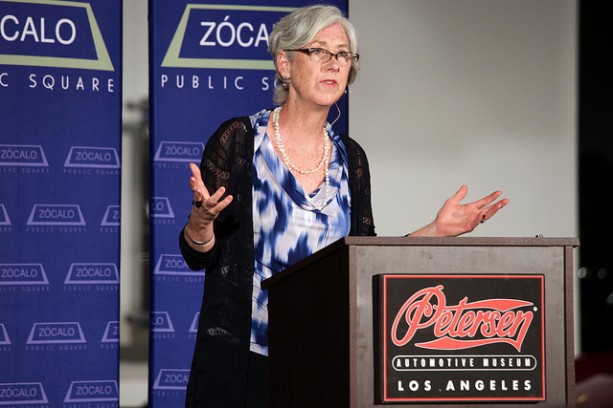
Early in her talk about the importance of giving patients the information they need to make medical decisions, Shannon Brownlee emphasized the relevance of the topic in dramatic fashion.
“How many of you have had an elective surgery?” she asked a full house at an event co-sponsored by Zócalo Public Square and the California HealthCare Foundation, prompting about a third of the crowd to raise their hands.
Brownlee, the acting director of the health policy program at the New America Foundation, defined elective procedures as any in which the patient has a choice. Prostate tests and mammograms are elective, she said, as are many bypass surgeries and joint replacement procedures. And too often, she argued, patients don’t have the information they need to make the right decision for themselves.
The Prostate Puzzle
 Brownlee opened her address by discussing the prostate-specific antigen, or PSA, test, which is recommended for men over 50 to test for early-stage prostate cancer. As the lead medical writer for U.S. News & World Report in the 1990s, she discovered some troubling statistics about the success of the PSA test.
Brownlee opened her address by discussing the prostate-specific antigen, or PSA, test, which is recommended for men over 50 to test for early-stage prostate cancer. As the lead medical writer for U.S. News & World Report in the 1990s, she discovered some troubling statistics about the success of the PSA test.
One-third of men who received the test weren’t informed that it was happening until after the fact, she found. And two-thirds of men who subsequently received treatment for prostate cancer – a procedure that can have major side effects including incontinence and impotence – said they didn’t receive enough information to make a good decision for themselves.
Most importantly, she said, “there wasn’t any evidence that giving men a PSA test actually reduced their risk of dying prematurely.”
Furthermore, the recommendations patients receive from their doctors are dictated by where they live. Residents of San Luis Obispo undergo treatment for prostate cancer at 10 times the rate of many other communities, she said, citing data from the renowned Dartmouth Health Atlas.
Yet despite the verified disparities and concerns about the procedure, the majority of doctors still give routine PSA tests without discussing other options, and most patients still don’t have the information they need to decide. But, Brownlee said, “a revolution is coming.”
The History of Tonsil Removal
 Brownlee spent a few moments tracing the evolution of how the medical community treats sore throats in children. The majority of adults over 50, she said, had their tonsils removed as children.
Brownlee spent a few moments tracing the evolution of how the medical community treats sore throats in children. The majority of adults over 50, she said, had their tonsils removed as children.
A study conducted in England demonstrated that far too many children were undergoing tonsillectomies, she said. A group of students were examined by a doctor, who concluded about 40 percent of them needed their tonsils removed. The school then sent the students deemed healthy to another doctor, who determined that 40 percent of the remaining group needed their tonsils removed. When a third doctor examined the remaining students, he concluded that 40 percent needed tonsillectomies.
“The expectation by physicians was that about 40 percent of them needed their tonsils out, and so that’s what they found,” Brownlee said. “It gives new meaning to the phrase ‘No child left behind.’”
Today, very few children have their tonsils removed, as more and more doctors conclude that there are other, less risky options to treat chronic sore throats. But meanwhile, other similarly unnecessary treatments have become more popular than ever. For example, mammograms are now recommended every year for women over 40, but Brownlee said the data does not show the procedure routinely prevents an early death.
Replacing Informed Consent
 Before undergoing any elective procedure, patients must sign a legal notice of “informed consent,” which states that they understand their options and have made an educated decision to take a particular path. But those documents are filled with legal jargon and don’t represent a true agreement between doctors and patients, Brownlee said.
Before undergoing any elective procedure, patients must sign a legal notice of “informed consent,” which states that they understand their options and have made an educated decision to take a particular path. But those documents are filled with legal jargon and don’t represent a true agreement between doctors and patients, Brownlee said.
And since elective procedures for Medicare patients cost U.S. taxpayers many billions of dollars a year, it’s crucial that those procedures are what patients really want.
The evidence shows that “when [patients] are informed, they often make different choices,” she said. “Doctors are often not very good at explaining things in a way we can understand.”
The “revolution” that Brownlee spoke of is the medical community slowly turning away from the informed consent model and toward what she calls shared decision-making. That requires work from both doctors and patients, she said.
For patients, Brownlee recommended a variety of steps. She emphasized the importance of soliciting second opinions, as well as asking for a patient decision aid, a brochure that walks through all a patient’s options and what they mean.
All patients should ask three questions before they undergo an elective test or procedure, she concluded: What are my options? Is doing nothing one of my options? What are the risks of each of the options, and what are the possible benefits?
In other words, she said, “Trust, but verify.”
For event photos, please click here.
For full video, please click here.
To read Anthony Iton’s essay on how zip code can determine lifespan, click here.
For four experts’ opinions on how to be better patients, please click here.
To read Brownlee’s essay on how health care can be more harm than help, click here.
Read Brownlee’s “In The Green Room” interview here.
*Photos by Aaron Salcido.




Send A Letter To the Editors